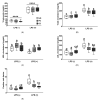Lowering n-6/ n-3 Ratio as an Important Dietary Intervention to Prevent LPS-Inducible Dyslipidemia and Hepatic Abnormalities in ob/ob Mice
- PMID: 35742829
- PMCID: PMC9224551
- DOI: 10.3390/ijms23126384
Lowering n-6/ n-3 Ratio as an Important Dietary Intervention to Prevent LPS-Inducible Dyslipidemia and Hepatic Abnormalities in ob/ob Mice
Abstract
Obesity is closely associated with low-grade chronic and systemic inflammation and dyslipidemia, and the consumption of omega-3 polyunsaturated fatty acids (n-3 PUFAs) may modulate obesity-related disorders, such as inflammation and dyslipidemia. An emerging research question is to understand the dietary intervention strategy that is more important regarding n-3 PUFA consumption: (1) a lower ratio of n-6/n-3 PUFAs or (2) a higher amount of n-3 PUFAs consumption. To understand the desirable dietary intervention method of n-3 PUFAs consumption, we replaced lard from the experimental diets with either perilla oil (PO) or corn oil (CO) to have identical n-3 amounts in the experimental diets. PO had a lower n-6/n-3 ratio, whereas CO contained higher amounts of PUFAs; it inherently contained relatively lower n-3 but higher n-6 PUFAs than PO. After the 12-week dietary intervention in ob/ob mice, dyslipidemia was observed in the normal chow and CO-fed ob/ob mice; however, PO feeding increased the high density lipoprotein-cholesterol (HDL-C) level; further, not only did the HDL-C level increase, the low density lipoprotein-cholesterol (LDL-C) and triglyceride (TG) levels also decreased significantly after lipopolysaccharide (LPS) injection. Consequently, extra TG accumulated in the liver and white adipose tissue (WAT) of normal chow- or CO-fed ob/ob mice after LPS injection; however, PO consumption decreased serum TG accumulation in the liver and WAT. PUFAs replacement attenuated systemic inflammation induced by LPS injection by increasing anti-inflammatory cytokines but inhibiting pro-inflammatory cytokine production in the serum and WAT. PO further decreased hepatic inflammation and fibrosis in comparison with the ND and CO. Hepatic functional biomarkers (aspartate aminotransferase (AST) and alanine transaminase (ALT) levels) were also remarkably decreased in the PO group. In LPS-challenged ob/ob mice, PO and CO decreased adipocyte size and adipokine secretion, with a reduction in phosphorylation of MAPKs compared to the ND group. In addition, LPS-inducible endoplasmic reticulum (ER) and oxidative stress decreased with consumption of PUFAs. Taken together, PUFAs from PO and CO play a role in regulating obesity-related disorders. Moreover, PO, which possesses a lower ratio of n-6/n-3 PUFAs, remarkably alleviated metabolic dysfunction in LPS-induced ob/ob mice. Therefore, an interventional trial considering the ratio of n-6/n-3 PUFAs may be desirable for modulating metabolic complications, such as inflammatory responses and ER stress in the circulation, liver, and/or WAT.
Keywords: cardiac risk factor; dyslipidemia; inflammation; obesity; perilla oil and corn oil; polyunsaturated fatty acids.
Conflict of interest statement
The authors declare no conflict of interest.
Figures


















Similar articles
-
Partial replacement of high-fat diet with n-3 PUFAs enhanced beef tallow attenuates dyslipidemia and endoplasmic reticulum stress in tunicamycin-injected rats.Front Nutr. 2023 Mar 16;10:1155436. doi: 10.3389/fnut.2023.1155436. eCollection 2023. Front Nutr. 2023. PMID: 37006935 Free PMC article.
-
Partial Replacement of Dietary Fat with Polyunsaturated Fatty Acids Attenuates the Lipopolysaccharide-Induced Hepatic Inflammation in Sprague-Dawley Rats Fed a High-Fat Diet.Int J Environ Res Public Health. 2021 Oct 19;18(20):10986. doi: 10.3390/ijerph182010986. Int J Environ Res Public Health. 2021. PMID: 34682732 Free PMC article.
-
Impact of feeding polyunsaturated fatty acids on cholesterol metabolism of dyslipidemic obese rats of WNIN/GR-Ob strain.Atherosclerosis. 2009 May;204(1):136-40. doi: 10.1016/j.atherosclerosis.2008.08.021. Epub 2008 Sep 2. Atherosclerosis. 2009. PMID: 18848326
-
n-3 Polyunsaturated fatty acids for the management of alcoholic liver disease: A critical review.Crit Rev Food Sci Nutr. 2019;59(sup1):S116-S129. doi: 10.1080/10408398.2018.1544542. Epub 2018 Dec 22. Crit Rev Food Sci Nutr. 2019. PMID: 30580553 Review.
-
Omega-3 fatty acids and adipose tissue biology.Mol Aspects Med. 2018 Dec;64:147-160. doi: 10.1016/j.mam.2018.01.004. Epub 2018 Jan 17. Mol Aspects Med. 2018. PMID: 29329795 Review.
Cited by
-
Partial replacement of high-fat diet with n-3 PUFAs enhanced beef tallow attenuates dyslipidemia and endoplasmic reticulum stress in tunicamycin-injected rats.Front Nutr. 2023 Mar 16;10:1155436. doi: 10.3389/fnut.2023.1155436. eCollection 2023. Front Nutr. 2023. PMID: 37006935 Free PMC article.
-
Effect of PUFAs-ω3 and ω6 on oxidative stress of sheep erythrocytes.BMC Vet Res. 2025 May 10;21(1):334. doi: 10.1186/s12917-025-04762-4. BMC Vet Res. 2025. PMID: 40346594 Free PMC article.
-
Gryllus bimaculatus Hydrolysate Ameliorates Obesity-Induced Muscle Atrophy by Activating Skeletal Muscle AMPK in Mice.Nutrients. 2025 Jun 12;17(12):1990. doi: 10.3390/nu17121990. Nutrients. 2025. PMID: 40573101 Free PMC article.
-
Effects of dietary adjustment of n-3:n-6 fatty-acid ratio to 1:2 on anti-inflammatory and insulin-signaling pathways in ovariectomized mice with high fat diet-induced obesity.Heliyon. 2023 Oct 3;9(10):e20451. doi: 10.1016/j.heliyon.2023.e20451. eCollection 2023 Oct. Heliyon. 2023. PMID: 37817999 Free PMC article.
-
Glucose-Dependent Insulinotropic Polypeptide Plasma Level Influences the Effect of n-3 PUFA Supplementation.Diagnostics (Basel). 2022 Aug 16;12(8):1984. doi: 10.3390/diagnostics12081984. Diagnostics (Basel). 2022. PMID: 36010335 Free PMC article.
References
-
- Bae J.C., Cho N.H., Suh S., Kim J.H., Hur K.Y., Jin S.M., Lee M.K. Cardiovascular disease incidence, mortality and case fatality related to diabetes and metabolic syndrome: A community-based prospective study (Ansung-Ansan cohort 2001-12) J. Diabetes. 2015;7:791–799. doi: 10.1111/1753-0407.12248. - DOI - PubMed
MeSH terms
Substances
Grants and funding
LinkOut - more resources
Full Text Sources
Miscellaneous

